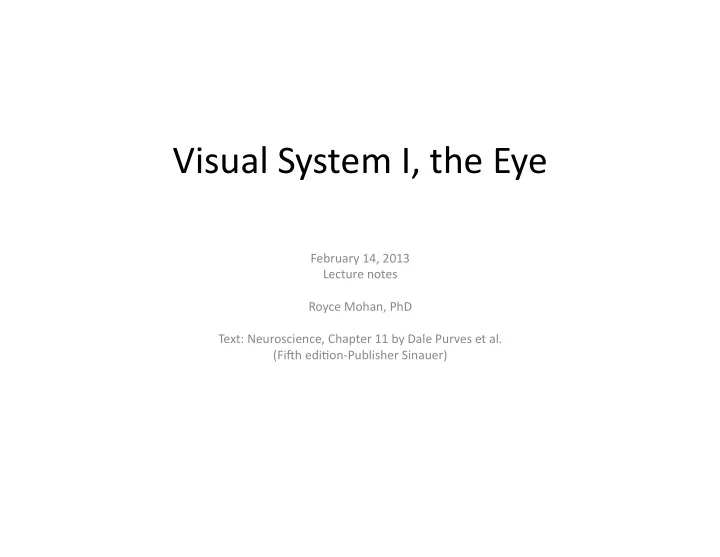

Visual System I, the Eye February 14, 2013 Lecture notes Royce Mohan, PhD Text: Neuroscience, Chapter 11 by Dale Purves et al. (FiJh ediLon‐Publisher Sinauer)
Learning ObjecDves • Understand the anatomy of the human eye • How images are formed on the reDna • Understand the process of phototransducDon • FuncDonal distribuDon of rods and cones • Circuitry for detecDon of light contrast • ReDnal circuits responsible for light adaptaDon • Concept of center‐surround in ganglion cells
Visual field The cornea provides ~60 percent of light refracDon, which the lens sharpens by changing its shape. ContracDon by ciliary muscles reduces tension on zonule fibers and allows the lens to become rounder for close‐up focusing; this is known as Accomoda&on . The central 10 o of the reDna is involved in tasks requiring high visual acuity (e.g. reading, texDng). About 40 o of the reDna is engaged in most other visual tasks (e.g. machine operaDon). However, the most peripheral part of temporal reDna is key for certain professionals (race car drivers and fighter pilots). Image recepDon and visual transducDon by photoreceptors converts light to chemical gradients, which post‐synapDc reDnal interneurons also use chemical gradients for early image processing. Final conversion of chemical signaling into acDon potenDals occurs only in reDnal ganglion cells that project to the brain. The rod and cone photoreceptors (GPCRs) use the special ligand 11‐cis reDnal for light capture. This acDvaDon triggers a cascade of intracellular biochemical events called phototransduc&on .
Bruchs Choroidal membrane Why does light not get back‐sca^ered by the blood vessels inner reDnal cells? The answer may lie in the ordered array of radial glia ( Müller cells ). Müller cells on average neighbor every photoreceptor cell and their processes run parallel to the light path from ganglion cell layer to the photoreceptor layer acDng like a fiber opDc system for focusing light on photoreceptors. Müller glia Müller cells also become acDvated during stress in the reDna. They are chiefly responsible for detoxificaDon of excess neurotransmi^ers (Glu, GABA, Gly, D‐Ser). With Dssue injury, acDvated Müller cells engage into a process known as reacDve gliosis. Müller cells proliferate and also dedifferenDate into neural precursor cells to repopulate the destroyed photoreceptors and interneurons. Chronic reacDve gliosis can be detrimental because it leads to the formaDon of scar Dssue. This scar Dssue pulls on delicate sensory neurons causing reDnal folds and as well this Dssue blocks the passage of light. ReacDve gliosis is one of the common underlying features of many leading blinding eye diseases, including age‐related macular degeneraDon, diabeDc reDnopathy and glaucoma. Vitreous
Muller cells may act as fiber op&c cables to focus light on photoreceptors vitreous ROS (a) Müller glial cell with rod outer segment Cover image of PNAS : Müller glial cells act as living (ROS) and a nearby bipolar cell (refracDve opDcal fibers, transporDng light through the inverted indices are numbered). ( b ) The refracDve index reDna of vertebrates. Image courtesy of Jens Grosche. (ability to transmit light) is measure as the waveguide characterisDc frequency ( V). This value remains fairly constant at 700 nm (orange) for the endfoot, the inner process the outer process of the Müller cells and also at 500 nm (blue). Franze K et al. PNAS 2007;104:8287-8292
Bruchs Choroidal Age‐related macular degeneraDon (AMD) affects membrane blood vessels central vision because cone cells at the fovea die (6 million Americans have it). This condiDon slowly develops into a more aggressive vascular proliferaDve condiDon in about 10% of cases. This involves the growth of choroidal blood vessels into the sensory reDna through disrupDon of Bruchs membrane. Early AMD can be diagnosed with a visual task (Amsler grid test) and followed by intraocular fundus examinaDon. ReDnal pigment epithelium (RPE) dysfuncDon in the central foveal region leads to drusen deposits, which Müller glia accumulate and promote cone photoreceptor cell loss. Amsler grid AMD Normal drusen Leaky vessels N Normal dry AMD wet‐AMD Vitreous Re:nal Fundus photography Mechanisms of Age‐Related Macular DegeneraDon. Neuron July 12, 2012
Real estate in the reDna is premium. Key to how this Dssue is funcDonally organized has to account for spaDal vision, contrast sensiDvity and visual Foveola acuity. Rods are more abundant at periphery (temporal and nasal), maximally at 20 o from the fovea. In the fovea (1.2 mm in diameter), cone density increases 200‐fold and at its center, the foveola (300 micrometer), only cone cells exist where their Dght packing is accomplished by having narrow outer segments. This region is also free from any reDnal blood vessels. Foveal metabolic funcDons are governed by the pigment epithelium, which is fed by an abundance of choriodal capillaries. Choroidal blood flow is also highest in fovea, being the Dssue with the highest blood flow in the body!
Rods and cones differ by their shape, light sensiDvity, photopigment, anatomical distribuDon Large recepDve field small recepDve field and synapDc connecDon with interneurons. Rods have poor resoluDon due to large recepDve field, but they are sensiDve to very low levels of light (starlight‐ Scotopic vision). Cones are most acDve at ambient lighDng and sunlight (Photopic vision), and have low sensiDvity. They have very high resoluDon due to small recepDve fields. Graded chemical Rods outnumber cones (90 million rods vs 4.5 potenDals million cones). Rods gain sensiDvity by having 15‐30 rods/bipolar cell; rod‐bipolar cells in turn form synapses with amacrine cells through gap ganglion cell ganglion cell juncDons. This addiDonal interneuron forming a synapse with ganglion cell disDnguishes the rod from cone circuits. acDon potenDal Single cone cells synapse with single bipolar cells that directly synapse with ganglion cells at the fovea. Cones do not saturate at high light intensity and can also recover 4X faster than rods to bright light, which allows us to read going from ambient light into bright light.
Recommend
More recommend